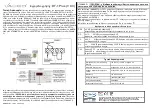
APPENDIX D LIST OF CAUTIONS
User’s Manual U16898EJ3V0UD
396
(10/17)
Chapter
Classification
Function Details
of
Function
Cautions Page
TXB6: Transmit
buffer register 6
Do not refresh (write the same value to) TXB6 by software during a
communication operation (when bit 7 (POWER6) and bit 6 (TXE6) of
asynchronous serial interface operation mode register 6 (ASIM6) are 1 or when
bit 7 (POWER6) and bit 5 (RXE6) of ASIM6 are 1).
p. 182
At startup, set POWER6 to 1 and then set TXE6 to 1. To stop the operation,
clear TXE6 to 0, and then clear POWER6 to 0.
p. 184
At startup, set POWER6 to 1 and then set RXE6 to 1. To stop the operation,
clear RXE6 to 0, and then clear POWER6 to 0.
p. 184
Set POWER6 to 1 and then set RXE6 to 1 while a high level is input to the RxD6
pin. If POWER6 is set to 1 and RXE6 is set to 1 while a low level is input,
reception is started.
p. 184
Clear the TXE6 and RXE6 bits to 0 before rewriting the PS61, PS60, and CL6 bits.
p. 184
Fix the PS61 and PS60 bits to 0 when mounting the device on LIN.
p. 184
Make sure that TXE6 = 0 when rewriting the SL6 bit. Reception is always
performed with “the number of stop bits = 1”, and therefore, is not affected by the
set value of the SL6 bit.
p. 184
ASIM6:
Registers
controlling
serial interface
UART6
Make sure that RXE6 = 0 when rewriting the ISRM6 bit.
p. 184
The operation of the PE6 bit differs depending on the set values of the PS61 and
PS60 bits of asynchronous serial interface operation mode register 6 (ASIM6).
p. 185
The first bit of the receive data is checked as the stop bit, regardless of the
number of stop bits.
p. 185
If an overrun error occurs, the next receive data is not written to receive buffer
register 6 (RXB6) but discarded.
p. 185
ASIS6:
Asynchronous
serial interface
reception error
status register 6
Be sure to read ASIS6 before reading receive buffer register 6 (RXB6).
pp. 185,
203
To transmit data continuously, write the first transmit data (first byte) to the TXB6
register. Be sure to check that the TXBF6 flag is “0”. If so, write the next
transmit data (second byte) to the TXB6 register. If data is written to the TXB6
register while the TXBF6 flag is “1”, the transmit data cannot be guaranteed.
p. 186
ASIF6:
Asynchronous
serial interface
transmission
status register 6 To initialize the transmission unit upon completion of continuous transmission, be
sure to check that the TXSF6 flag is “0” after generation of the transmission
completion interrupt, and then execute initialization. If initialization is executed
while the TXSF6 flag is “1”, the transmit data cannot be guaranteed.
p. 186
CKSR6: Clock
selection
register 6
Make sure POWER6 = 0 when rewriting TPS63 to TPS60.
p. 187
Soft
Make sure that bit 6 (TXE6) and bit 5 (RXE6) of the ASIM6 register = 0 when
rewriting the MDL67 to MDL60 bits.
p. 188
Hard
BRGC6: Baud
rate generator
control register
6
The baud rate is the output clock of the 8-bit counter divided by 2.
p. 188
ASICL6 can be refreshed (the same value is written) by software during a
communication operation (when bit 7 (POWER6) and bit 6 (TXE6) of ASIM6 = 1
or bit 7 (POWER6) and bit 5 (RXE6) of ASIM6 = 1). However, if the SBRT6 = 1
and SBTT = 1 are set in the refresh operation during the SBF reception (SBRF6
= 1) or SBF transmission (between the SBTT6 setting (1) and the INTST6
occurrence), it triggers the SBF reception and SBF transmission again, so do not
set.
p. 189
Chapter 11
Soft
Serial
interface
UART6
ASICL6:
Asynchronous
serial interface
control register
6
In the case of an SBF reception error, return the mode to the SBF reception
mode again and hold (1) the status of the SBRF6 flag.
p. 190















































